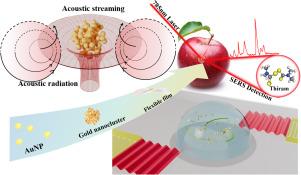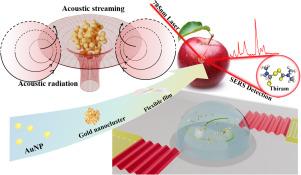Flexible SERS substrate based on active nanoparticle enrichment for ultra-trace in situ detection
IF 3.7
1区 化学
Q1 CHEMISTRY, ANALYTICAL
引用次数: 0
Abstract
Surface-enhanced Raman spectroscopy (SERS) has emerged as a powerful technique for applications in food safety testing, environmental monitoring, disease diagnosis, and molecular characterization. However, conventional SERS substrates frequently suffer from limited sensitivity, poor signal uniformity, and dependence on skilled operators. In this study, a flexible and high-performance SERS sensing strategy is proposed, which is based on surface acoustic wave (SAW)-induced clustering of 50 nm gold nanoparticles (AuNPs). When a L AuNP colloidal droplet is dispensed onto the SAW propagation region, acoustic streaming drives the aggregation of nanoparticles. Upon complete evaporation of the droplet, densely packed SERS-active hotspots are formed, enabling strong Raman signal enhancement. By optimizing the thickness of the PDMS flexible film and the input power, the resulting Raman substrate exhibits minimum detectable concentration reaching 10−13 M for rhodamine 6G (R6G), 10−10 M for 4-aminothiophenol (4-ATP), and 10−11 M for crystal violet (CV)—as well as excellent reproducibility. The relative standard deviation (RSD) for CV detection decreased from 45.32% (SAW-free) to 3.59% under SAW-assisted enrichment, confirming the significant improvement in signal uniformity. Finally, the flexible SAW-SERS sensor demonstrates a sensitivity of up to 10−8 M for detecting Thiram residues on apple surfaces. This flexible SAW-assisted SERS substrate offers a promising strategy for portable, efficient, and reliable environmental and food safety monitoring.


基于活性纳米颗粒富集的柔性SERS衬底用于超痕量原位检测
表面增强拉曼光谱(SERS)已成为食品安全检测、环境监测、疾病诊断和分子表征等领域的一项强大技术。然而,传统的SERS基板经常遭受有限的灵敏度,信号均匀性差,并依赖于熟练的操作员。本研究提出了一种基于表面声波(SAW)诱导的50 nm金纳米粒子(AuNPs)聚类的柔性高性能SERS传感策略。当5μ5μL的AuNP胶体液滴被分配到SAW传播区时,声流驱动纳米粒子聚集。在液滴完全蒸发后,形成密集排列的sers活性热点,实现强拉曼信号增强。通过优化PDMS柔性薄膜的厚度和输入功率,得到的拉曼衬底的最小可检测浓度为罗丹明6G (R6G)为10−13 M, 4-氨基噻吩(4-ATP)为10−10 M,结晶紫(CV)为10−11 M,并且具有良好的再现性。在无saw的情况下,CV检测的相对标准偏差(RSD)从45.32%下降到3.59%,证实了信号均匀性的显著提高。最后,柔性SAW-SERS传感器显示了高达10−8 M的灵敏度,用于检测苹果表面的Thiram残留物。这种灵活的saw辅助SERS基板为便携式、高效、可靠的环境和食品安全监测提供了一种有前途的策略。
本文章由计算机程序翻译,如有差异,请以英文原文为准。
求助全文
约1分钟内获得全文
求助全文
来源期刊

Sensors and Actuators B: Chemical
工程技术-电化学
CiteScore
14.60
自引率
11.90%
发文量
1776
审稿时长
3.2 months
期刊介绍:
Sensors & Actuators, B: Chemical is an international journal focused on the research and development of chemical transducers. It covers chemical sensors and biosensors, chemical actuators, and analytical microsystems. The journal is interdisciplinary, aiming to publish original works showcasing substantial advancements beyond the current state of the art in these fields, with practical applicability to solving meaningful analytical problems. Review articles are accepted by invitation from an Editor of the journal.
 求助内容:
求助内容: 应助结果提醒方式:
应助结果提醒方式:


